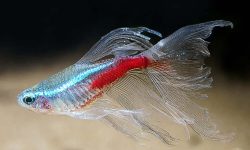Among the most visually striking inhabitants of coral reefs, the Unicornfish (Naso unicornis) is instantly recognizable by the prominent horn-like protrusion jutting from its forehead. Also known as the Bluespine Unicornfish, this large, herbivorous reef fish is not only anatomically unique but ecologically vital. Found primarily in the Indo-Pacific, it plays a central role in regulating algal growth on coral reefs, maintaining balance within fragile ecosystems. This article explores in depth the anatomy, feeding behavior, and survival strategies of the Unicornfish, shedding light on why this species thrives in such a competitive and dynamic marine environment.

Anatomical Wonders: How the Unicornfish Is Built for Reef Life
The Iconic Horn: A Symbol with Mystery
The Unicornfish’s defining feature, the horn, develops only in adults and remains a subject of scientific speculation. Structurally composed of soft tissue rather than bone, it may serve multiple purposes: aiding species recognition, playing a role in social hierarchies, or serving as a hydrodynamic aid while swimming.
Streamlined Body for Coral Navigation
The Unicornfish has a long, laterally compressed body, allowing it to slip gracefully between reef crevices. Its caudal fin is deeply forked and crescent-shaped, providing powerful propulsion for sudden bursts of speed. Its overall body structure is built for agility rather than brute strength, making it adept at evading predators.
Specialized Mouthparts and Teeth
Positioned at the end of an elongated snout, the Unicornfish’s small, chisel-like teeth are perfectly adapted for scraping algae from rocks. These teeth grow continuously, compensating for the wear caused by constant grazing on rough surfaces. The fish’s jaws are reinforced to generate sufficient force for rasping tough plant material.
Defensive Structures: Tail Spines and Skin Secretion
The species is named “Bluespine” for the sharp, retractable spines located on either side of its caudal peduncle (the base of the tail). These spines act as defense mechanisms, slashing at predators when threatened. Additionally, the Unicornfish secretes a mucus layer with mild toxins, potentially deterring parasites and predators.
Feeding Ecology: Why Brown Algae Is the Unicornfish’s Favorite Food
Diet Composition: A Preference for Tough Algae
Unicornfish are primarily herbivores, feeding on benthic algae, particularly brown algae (Phaeophyceae). Brown algae contain complex carbohydrates and are more fibrous than green algae, requiring robust digestive adaptations. The preference for this nutrient-dense, high-fiber algae sets them apart from more generalist reef herbivores.
Feeding Strategy: Grazing on the Move
Rather than browsing passively, Unicornfish actively graze across hard substrates. Their feeding involves methodical scraping motions, often in small groups, which maximizes foraging efficiency while reducing individual exposure to predators. This group behavior also prevents territorial disputes common among solitary grazers.
Digestive Adaptations for Plant Matter
To process their fibrous diet, Unicornfish possess an extended gastrointestinal tract where microbial fermentation aids in breaking down cellulose. Specialized enzymes produced in the gut further assist in extracting energy from otherwise indigestible components. This gut microbiota partnership is essential for maximizing nutrient uptake from algae.
Ecological Role as Reef Gardeners
By grazing on fast-growing algae, Unicornfish prevent algal overgrowth that could otherwise smother corals. This makes them crucial agents in reef maintenance, enhancing coral health and biodiversity. Their feeding indirectly supports fish larvae and invertebrate populations dependent on open coral surfaces.
Comparison with Other Herbivores
While Parrotfish also feed on algae, they crush coral to access it, sometimes causing structural damage. Surgeonfish (close relatives of Unicornfish) often graze on softer, filamentous algae. Unicornfish are unique in selectively targeting tougher brown algae without harming coral skeletons, balancing efficiency with conservation.
Reef Survival Strategies: Social Behavior, Escape Mechanisms, and Reproduction
Group Living and Social Intelligence
Escape Tactics and Predator Avoidance
When threatened, Unicornfish rely on a combination of speed, agility, and deterrence. Their streamlined shape enables quick darting movements. If pursued, they may flash their tail spines outward to slash or startle predators. The mucus coating on their skin also provides a slippery surface, making them difficult to grasp.
Sensory Systems and Navigation
Unicornfish possess highly sensitive lateral lines that detect changes in water pressure and movement, allowing them to sense nearby objects or animals. Their vision is well-adapted to detecting motion and contrast in the dynamic lighting conditions of reef habitats. These sensory inputs are critical for both predator detection and fine-scale navigation around corals.
Reproductive Strategy and Lifecycle
Reproduction occurs through broadcast spawning, where males and females release gametes into the open water. Spawning typically happens in synchrony with lunar cycles to increase success. Larvae drift in planktonic form for several weeks before settling on reef areas to mature. This dispersal strategy increases genetic diversity and colonization potential.
Environmental Threats and Adaptive Limitations
Despite their adaptations, Unicornfish face threats from coral bleaching, overfishing, and pollution. Because their diet is tightly linked to algal availability on healthy reefs, degradation of coral ecosystems directly impacts their survival. Their specialized nature, once an evolutionary advantage, now makes them vulnerable in rapidly changing environments.
Conclusion
The Unicornfish (Naso unicornis) exemplifies how anatomical precision, dietary specialization, and behavioral complexity can converge to create a successful reef-dwelling species. Its distinctive features—from the horn-like forehead to the algae-scraping teeth and defensive tail spines—are all intricately tuned to coral reef life. As grazers, they not only sustain themselves but also sustain the reef, protecting biodiversity and ecological balance. Understanding the biology and survival strategies of the Unicornfish is not only fascinating in its own right but vital for informing conservation efforts in the face of accelerating ocean change.
In studying these marine unicorns, we discover a masterclass in evolutionary adaptation—and a warning: that even the best-adapted creatures need a healthy environment to thrive.






